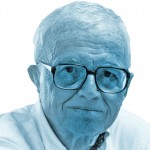
Central Park and I go back almost as far as a man and a park can go. In the early 1930s, when my sisters and I were children, we sometimes stayed overnight with our grandmother, who lived at 1 West 69th Street. Unskilled at amusing the young, she would give us loaves of stale bread, saved for just such an emergency, and send us across the street into the park to feed the sheep.
At that time Central Park had a flock of 300 sheep that grazed on the vast Sheep Meadow, as it’s still called today, and thereby kept it mowed. They were housed in an edifice that was built especially for them in 1871, just inside the park at 67th Street. Ambitious beyond the usual dreams of sheepfold architecture, it had Victorian Gothic gables and spires and was clothed in polychrome red brick–a masonry style that would become the signature of all the park’s small buildings. This was the temple to which my sisters and I came bearing our gift of stale bread. Seeing us, the sheep would poke their snouts through slots in the fence that enclosed their courtyard and would nibble at our childish fingers.
In 1934 the sheep were dispossessed, the Central Park shepherd was retired, and the building was leased to a businessman who converted it into a restaurant called the Tavern on the Green, where a different kind of sheep came to be fed. He decorated the interior in High Bordello style, with glittering mirrors and crystal chandeliers, and in that guise it became a favored roost for tourists and wedding parties. Two years ago it reverted to the Parks Department, which has since stripped away the Tavern’s glitz and is looking for a new tenant.
But even without my sheep it’s still my Central Park, never far from my thoughts–a landscape of amazing trees and interlaced paths and lakes and bridges set apart from the city’s rectilinear grid. My wife goes there to look for birds. The bird I go looking for is a jazz saxophonist who once played with Earl Hines’s band and now freelances on the Great Mall. I sit on a park bench with a hot dog and a lot of mustard and bask in the melodies of Harold Arlen and Duke Ellington.
Around me, people of every age and size move to every known mode of locomotion. They walk, they jog, they run, they bike, they skateboard, they roller-skate, they Rollerblade, they get pushed in strollers, they break-dance, they hip-hop, often to Afro-Cuban rhythms slapped on drums. Just north of where I sit, couples in rowboats circumnavigate a lake that looks just as it did when it was drawn for Currier & Ives. Farther north, baseball teams compete on diamonds with real backstops. Elsewhere, people play chess, tennis, croquet, and bowls. In the winter they ice-skate and go sledding. Farther north, in Harlem Meer, they fish. It’s a park where people have always been able to figure out what they want to do and where to do it.
I was therefore startled, the other day, to see an advertisement by the Central Park Conservancy, the nonprofit agency that rescued the park from decay and despair 20 years ago and has since nurtured it with utmost care and love. “Download our app,” the ad said, “and experience Central Park right in the palm of your hand.” I understand the purpose of the ad: to make the park’s resources more widely known to potential visitors and supporters.
But I also wondered if I was getting a glimpse of the future–of the day when every organization has an app and nobody goes anywhere. I already have an app for major league baseball. It’s called a television set. I sit in my apartment and watch the Mets and the Yankees without paying the owners their piratical price for admission and food. Will the Metropolitan Museum of Art be next to join the app brigade? “Avoid the crowds! Download Rembrandt on your smartphone.” Or the Museum of Natural History? “Simply click on dinosaur or whale.”
With the approach of summer I’m hoping to hear of a new app created by Jones Beach, telling me what it feels like to romp in the surf and lie on the sand. “No more messy sunscreens! Now you can experience a day at the beach in the palm of your hand!”

